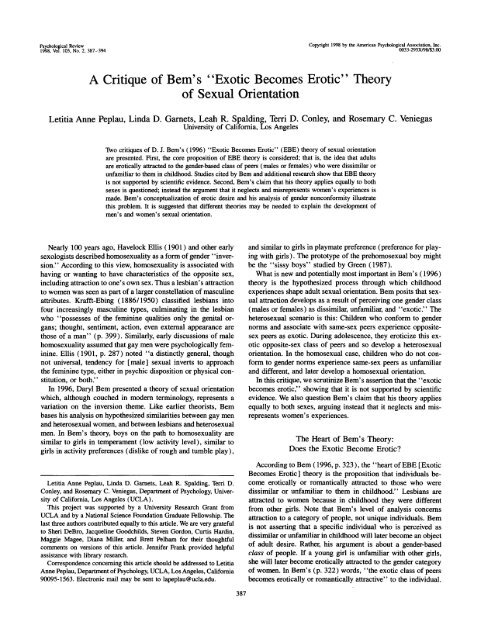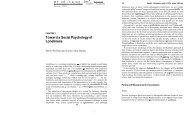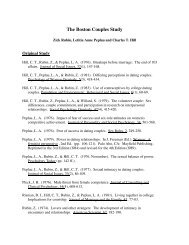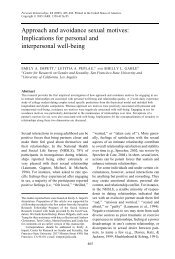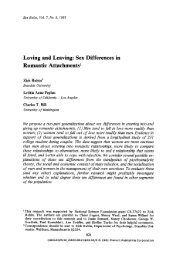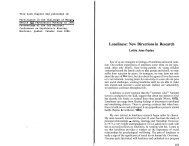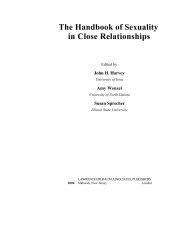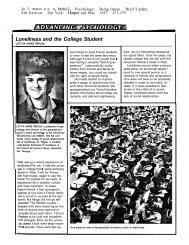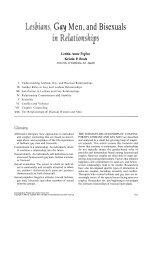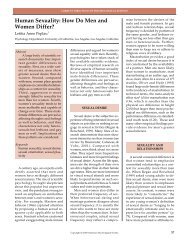"Exotic Becomes Erotic" Theory of Sexual Orientation - Anne Peplau ...
"Exotic Becomes Erotic" Theory of Sexual Orientation - Anne Peplau ...
"Exotic Becomes Erotic" Theory of Sexual Orientation - Anne Peplau ...
Create successful ePaper yourself
Turn your PDF publications into a flip-book with our unique Google optimized e-Paper software.
Psychological Review<br />
1998, Vol. 105, No. 2, 387-394<br />
Copyright 1998 by the American Psychological Association, Inc.<br />
0033-295X/98/$3.00<br />
A Critique <strong>of</strong> Bern's "<strong>Exotic</strong> <strong>Becomes</strong> Erotic" <strong>Theory</strong><br />
<strong>of</strong> <strong>Sexual</strong> <strong>Orientation</strong><br />
Letitia <strong>Anne</strong> <strong>Peplau</strong>, Linda D. Garnets, Leah R. Spalding, Terri D. Conley, and Rosemary C. Veniegas<br />
University <strong>of</strong> California, Los Angeles<br />
Two critiques <strong>of</strong> D. J. Bern's (1996) "<strong>Exotic</strong> <strong>Becomes</strong> Erotic" (EBE) theory <strong>of</strong> sexual orientation<br />
are presented. First, the core proposition <strong>of</strong> EBE theory is considered; that is, the idea that adults<br />
are erotically attracted to the gender-based class <strong>of</strong> peers (males or females) who were dissimilar or<br />
unfamiliar to them in childhood. Studies cited by Bern and additional research show that EBE theory<br />
is not supported by scientific evidence. Second, Bern's claim that his theory applies equally to both<br />
sexes is questioned; instead the argument that it neglects and misrepresents women's experiences is<br />
made. Bern's conceptualization <strong>of</strong> erotic desire and his analysis <strong>of</strong> gender nonconformity illustrate<br />
this problem. It is suggested that different theories may be needed to explain the development <strong>of</strong><br />
men's and women's sexual orientation.<br />
Nearly 100 years ago, Havelock Ellis (1901) and other early<br />
sexologists described homosexuality as a form <strong>of</strong> gender "inversion."<br />
According to this view, homosexuality is associated with<br />
having or wanting to have characteristics <strong>of</strong> the opposite sex,<br />
including attraction to one's own sex. Thus a lesbian's attraction<br />
to women was seen as part <strong>of</strong> a larger constellation <strong>of</strong> masculine<br />
attributes. Krafft-Ebing (1886/1950) classified lesbians into<br />
four increasingly masculine types, culminating in the lesbian<br />
who "possesses <strong>of</strong> the feminine qualities only the genital organs;<br />
thought, sentiment, action, even external appearance are<br />
those <strong>of</strong> a man" (p. 399). Similarly, early discussions <strong>of</strong> male<br />
homosexuality assumed that gay men were psychologically feminine.<br />
Ellis (1901, p. 287) noted "a distinctly general, though<br />
not universal, tendency for [male] sexual inverts to approach<br />
the feminine type, either in psychic disposition or physical constitution,<br />
or both.''<br />
In 1996, Daryl Bern presented a theory <strong>of</strong> sexual orientation<br />
which, although couched in modern terminology, represents a<br />
variation on the inversion theme. Like earlier theorists, Bern<br />
bases his analysis on hypothesized similarities between gay men<br />
and heterosexual women, and between lesbians and heterosexual<br />
men. In Bern's theory, boys on the path to homosexuality are<br />
similar to girls in temperament (low activity level), similar to<br />
girls in activity preferences (dislike <strong>of</strong> rough and tumble play),<br />
Letitia <strong>Anne</strong> <strong>Peplau</strong>, Linda D. Garnets, Leah R. Spalding, Terri D.<br />
Conley, and Rosemary C. Veniegas, Department <strong>of</strong> Psychology, University<br />
<strong>of</strong> California, Los Angeles (UCLA).<br />
This project was supported by a University Research Grant from<br />
UCLA and by a National Science Foundation Graduate Fellowship. The<br />
last three authors contributed equally to this article. We are very grateful<br />
to Sheri DeBro, Jacqueline Goodchilds, Steven Gordon, Curtis Hardin,<br />
Maggie Magee, Diana Miller, and Brett Pelham for their thoughtful<br />
comments on versions <strong>of</strong> this article. Jennifer Frank provided helpful<br />
assistance with library research.<br />
Correspondence concerning this article should be addressed to Letitia<br />
<strong>Anne</strong> <strong>Peplau</strong>, Department <strong>of</strong> Psychology, UCLA, Los Angeles, California<br />
90095-1563. Electronic mail may be sent to lapeplau@ucla.edu.<br />
387<br />
and similar to girls in playmate preference (preference for playing<br />
with girls). The prototype <strong>of</strong> the prehomosexual boy might<br />
be the "sissy boys" studied by Green (1987).<br />
What is new and potentially most important in Bern's (1996)<br />
theory is the hypothesized process through which childhood<br />
experiences shape adult sexual orientation. Bern posits that sexual<br />
attraction develops as a result <strong>of</strong> perceiving one gender class<br />
(males or females) as dissimilar, unfamiliar, and "exotic." The<br />
heterosexual scenario is this: Children who conform to gender<br />
norms and associate with same-sex peers experience oppositesex<br />
peers as exotic. During adolescence, they eroticize this exotic<br />
opposite-sex class <strong>of</strong> peers and so develop a heterosexual<br />
orientation. In the homosexual case, children who do not conform<br />
to gender norms experience same-sex peers as unfamiliar<br />
and different, and later develop a homosexual orientation.<br />
In this critique, we scrutinize Bern's assertion that the' 'exotic<br />
becomes erotic," showing that it is not supported by scientific<br />
evidence. We also question Bern's claim that his theory applies<br />
equally to both sexes, arguing instead that it neglects and misrepresents<br />
women's experiences.<br />
The Heart <strong>of</strong> Bern's <strong>Theory</strong>:<br />
Does the <strong>Exotic</strong> Become Erotic?<br />
According to Bern (1996, p. 323), the ' 'heart <strong>of</strong> EBE [<strong>Exotic</strong><br />
<strong>Becomes</strong> Erotic] theory is the proposition that individuals become<br />
erotically or romantically attracted to those who were<br />
dissimilar or unfamiliar to them in childhood." Lesbians are<br />
attracted to women because in childhood they were different<br />
from other girls. Note that Bern's level <strong>of</strong> analysis concerns<br />
attraction to a category <strong>of</strong> people, not unique individuals. Bern<br />
is not asserting that a specific individual who is perceived as<br />
dissimilar or unfamiliar in childhood will later become an object<br />
<strong>of</strong> adult desire. Rather, his argument is about a gender-based<br />
class <strong>of</strong> people. If a young girl is unfamiliar with other girls,<br />
she will later become erotically attracted to the gender category<br />
<strong>of</strong> women. In Bern's (p. 322) words, "the exotic class <strong>of</strong> peers<br />
becomes erotically or romantically attractive'' to the individual.
388 THEORETICAL NOTES<br />
Although "exotic" is the central concept in EBE theory, Bern<br />
(1996) <strong>of</strong>fers no definition <strong>of</strong> the term, which he generally<br />
equates with being unfamiliar or dissimilar from oneself. Sometimes<br />
Bern seems to refer to objective familiarity and similarity;<br />
more <strong>of</strong>ten he emphasizes perceptions <strong>of</strong> difference. Bern suggests<br />
that there may be an optimal level <strong>of</strong> exoticism, but does<br />
not discuss how this level could be determined. Unfortunately,<br />
the example that Bern uses to illustrate optimal exoticism—<br />
that an erotic interest in human partners <strong>of</strong> a different race or<br />
ethnicity is common but a preference for "lying with the beasts<br />
in the field is not'' (p. 325) —is irrelevant to the issue <strong>of</strong> sexual<br />
orientation. We agree that attraction to a specific individual<br />
may be sparked by the novelty <strong>of</strong> the new partner's cultural<br />
background, but this individual-level phenomenon is not informative<br />
about how gender exoticism affects attraction to an entire<br />
class <strong>of</strong> peers. The unanswered question for EBE theory concerns<br />
the type or degree <strong>of</strong> gender exoticism needed to influence<br />
sexual orientation.<br />
Bern (1996) does not present new data testing his theory, but<br />
rather culls supportive illustrations from the published literature.<br />
In this critique, we reexamine research cited by Bern, <strong>of</strong>ten<br />
questioning his interpretation <strong>of</strong> these studies. We also present<br />
additional research not cited by Bern that challenges or disconfirms<br />
aspects <strong>of</strong> his theory.<br />
Although the empirical database on homosexuality has grown<br />
in the past two decades (e.g., Garnets & Kimmel, 1993), existing<br />
research remains limited. Most studies <strong>of</strong> sexual orientation<br />
are based on relatively small samples. The use <strong>of</strong> retrospective<br />
reports about childhood experiences is common and can<br />
lead to problems <strong>of</strong> reconstructed memory (Ross, 1980). Comparative<br />
studies have <strong>of</strong>ten used different recruitment methods<br />
for heterosexual and homosexual participants and this may bias<br />
the resulting samples in important but unknown ways. All studies<br />
<strong>of</strong> the childhood antecedents <strong>of</strong> sexual orientation are based<br />
on unrepresentative samples. This point is important because<br />
Bern repeatedly claims to describe the modal or most common<br />
developmental sequence. Until studies <strong>of</strong> representative samples<br />
are available, claims about modal patterns leading to homosexuality<br />
are untestable and cannot be verified scientifically.<br />
Nonetheless, available research does provide some basis for<br />
evaluating the general adequacy <strong>of</strong> Bern's theory. In the next<br />
sections, we consider the two elements <strong>of</strong> exoticism—similarity<br />
and familiarity—and their links to adult erotic attraction.<br />
Similarity and <strong>Sexual</strong> <strong>Orientation</strong><br />
EBE theory hypothesizes that people become erotically attracted<br />
to the gender class <strong>of</strong> peers who were dissimilar to<br />
them in childhood. EBE theory would be supported by research<br />
linking childhood feelings <strong>of</strong> difference to adult sexual orientation.<br />
Bern <strong>of</strong>fers evidence on this crucial point from only one<br />
study. In 1969-1970, Bell, Weinberg, and Hammersmith<br />
(198la, 1981b) interviewed homosexual and heterosexual men<br />
and women in the San Francisco area. They recruited heterosexuals<br />
through stratified random sampling but recruited gay men<br />
and lesbians from gay bars, public ads, personal contacts, parks,<br />
and public restrooms. Respondents were asked "to what extent<br />
do you think you were different from the [same-sex children]<br />
your age'' in grade school? We do not know how the noncompa-<br />
rability <strong>of</strong> the heterosexual and homosexual recruitment and<br />
the retrospective nature <strong>of</strong> the data affected the results <strong>of</strong> this<br />
study, but it is possible that they may have exaggerated the extent<br />
<strong>of</strong> true differences between heterosexual and homosexual<br />
respondents.<br />
Bern reports that significantly more lesbians (70%) than heterosexual<br />
women (51%) recalled feeling somewhat or very different<br />
from other girls their age. Note, however, that regardless<br />
<strong>of</strong> sexual orientation, the majority <strong>of</strong> women reported feeling<br />
different from other girls their age. Turning to men, 71% <strong>of</strong> gay<br />
men reported feeling different from other boys, but so did 38%<br />
<strong>of</strong> heterosexual men. The difference for men is larger, but still<br />
indicates that feeling different from same-sex peers was common<br />
for heterosexual men. Perhaps because so many heterosexuals<br />
remember feeling different, Bern goes on to note that heterosexuals<br />
and homosexuals gave different reasons for feeling different<br />
(e.g., gay men tended to say they disliked sports;<br />
heterosexual men cited reasons such as being poor or introverted)<br />
. This seems to suggest that the reasons for feeling different<br />
matter: Girls who felt different from other girls because <strong>of</strong><br />
their appearance became heterosexuals but girls who felt different<br />
because they liked sports became lesbians. However, later<br />
in his analysis, Bern contradicts this interpretation, noting that<br />
"the effect <strong>of</strong> any childhood variable on an individual's sexual<br />
orientation depends on whether it prompts him or her to feel<br />
more similar to or different from same-sex or opposite-sex<br />
peers" (p. 331). Bern gives examples <strong>of</strong> children who feel<br />
different not only for gender-related reasons but also because<br />
<strong>of</strong> a physical disability or illness. How, then, are we to explain<br />
why feelings <strong>of</strong> difference based on income, introversion, or<br />
appearance did not affect the sexual orientation <strong>of</strong> heterosexuals<br />
in the San Francisco study?<br />
A stronger test <strong>of</strong> EBE theory would be provided by statistical<br />
analyses attempting to link childhood experiences to adult sexual<br />
orientation. The San Francisco researchers conducted such<br />
analyses, and Bern cites them in support <strong>of</strong> this theory. It should<br />
be emphasized that the path analyses reported by Bell et al.<br />
(1981a, 1981b) included many variables that are not part <strong>of</strong><br />
EBE theory and do not really provide an adequate test <strong>of</strong> Bern's<br />
ideas. Consequently, specific findings can be cited that appear<br />
to support and to disconfirm EBE theory. For instance, in support<br />
<strong>of</strong> his theory, Bern notes (p. 323) that for women, "feeling<br />
different from same-sex peers during childhood remained significant<br />
during adolescence,'' which he takes as evidence <strong>of</strong> the<br />
temporal stability <strong>of</strong> feeling different. Bern does not report,<br />
however, the failure <strong>of</strong> the path analyses to show the crucial<br />
theoretical link between feelings <strong>of</strong> difference in childhood and<br />
adult sexual orientation. Describing results for women, the authors<br />
commented: "Our path analysis indicates . . . that such<br />
feelings <strong>of</strong> alienation did not in and <strong>of</strong> themselves play a role<br />
in our respondents' becoming homosexual. The variables about<br />
feeling different from other girls were eliminated" from the<br />
path analysis (Bell et al., 1981a, pp. 157-158; see also Bell et<br />
al., 1981b, pp. 198, 275). Similarly for men, feelings <strong>of</strong> difference<br />
in childhood were not a significant predictor <strong>of</strong> adult sexual<br />
orientation.<br />
Familiarity and <strong>Sexual</strong> <strong>Orientation</strong><br />
A second aspect <strong>of</strong> exoticism is familiarity, a concept that is<br />
not explicitly defined by Bern (1996). Does familiarity refer
to mere exposure to peers, knowledge about peers, or actual<br />
interaction? Is a boy "familiar" with other boys if he goes to<br />
a coeducational school? has two older brothers? has a very close<br />
male friend? or watches ehildrens' TV shows? Bern does not<br />
discuss the nature or the degree <strong>of</strong> familiarity required to prevent<br />
versus spark erotic attraction to a gender class <strong>of</strong> peers.<br />
In support <strong>of</strong> the link between familiarity and sexual orientation,<br />
Bern again draws on the San Francisco survey, which asked<br />
homosexuals and heterosexuals retrospective questions about<br />
their childhood experiences. Bern notes that homosexuals were<br />
more likely than heterosexuals to remember having had many<br />
childhood friends <strong>of</strong> the other sex: 42% <strong>of</strong> gay men but only<br />
13% <strong>of</strong> heterosexual men said that "most childhood friends"<br />
were girls. Similarly, 60% <strong>of</strong> lesbians but only 40% <strong>of</strong> heterosexual<br />
women said that "most childhood friends" were boys.<br />
Do these data indicate that gay men and lesbians were unfamiliar<br />
with members <strong>of</strong> their own sex in childhood?<br />
Our examination <strong>of</strong> data from the San Francisco study leads<br />
to an opposite conclusion: virtually all respondents were familiar<br />
with children <strong>of</strong> both sexes. The vast majority <strong>of</strong> men in the<br />
San Francisco study reported having male friends in childhood.<br />
Only 9% <strong>of</strong> gay men said that "none or only a few" <strong>of</strong> their<br />
friends were male, and most gay men (74%) reported having<br />
"an especially close friend <strong>of</strong> the same sex" during grade<br />
school. TUrning to women, only 24% <strong>of</strong> lesbians said that most<br />
or all <strong>of</strong> their childhood friends were boys, and most lesbians<br />
(71%) reported having an especially close friendship with a<br />
girl. In short, the modal case for both heterosexuals and homosexuals<br />
and for both women and men in this sample was to<br />
have had a close same-sex friend and to have had a significant<br />
proportion <strong>of</strong> friends <strong>of</strong> the same sex.<br />
Another factor that might affect familiarity is the sex ratio<br />
<strong>of</strong> a person's siblings. Six studies have investigated this issue<br />
among men (see Blanchard & Zucker, 1994). From EBE theory,<br />
we would expect gay men to be less familiar with boys and<br />
therefore to have fewer brothers than heterosexual men. All<br />
studies have failed to confirm this prediction. For example, Bell<br />
et al. (198la, 1981b) found no differences between heterosexuals<br />
and homosexuals in the number or proportion <strong>of</strong> brothers<br />
and sisters. Blanchard and Sheridan (1992) found that gay men<br />
have an unusually high proportion <strong>of</strong> brothers. Recently, Blanchard<br />
and Bogaert (19%) reported that gay men were more likely<br />
than heterosexual men to have older brothers, but not younger<br />
brothers. Bern (1996, p. 331) has attempted to view these recent<br />
findings as supporting his theory, suggesting that a link between<br />
having older brothers and being gay "could come about, in part,<br />
if having gender-conforming older brothers especially enhances<br />
a gender-nonconforming boy's sense <strong>of</strong> being different from<br />
other boys." So in this case, Bern suggests, greater familiarity<br />
actually increases feelings <strong>of</strong> difference. The difficulty in deriving<br />
clear-cut predictions from EBE theory exemplified here and<br />
the lack <strong>of</strong> specification about the association between familiarity<br />
and feelings <strong>of</strong> difference are both serious weaknesses in<br />
Bern's analysis.<br />
Bern (1996) also <strong>of</strong>fers several cross-cultural examples <strong>of</strong><br />
the theorized link between childhood gender familiarity and<br />
adult sexual orientation. As we will show, none <strong>of</strong> these actually<br />
supports EBE theory. One illustration concerns arranged marriages<br />
in which future spouses live together during childhood.<br />
THEORETICAL NOTES 389<br />
Bern notes that in these cases, the spouses <strong>of</strong>ten experience<br />
problems in their sexual relations with each other as adults.<br />
In this case, intense childhood familiarity with one individual<br />
diminishes subsequent erotic attraction to that individual. This<br />
observation does not support EBE theory for two reasons. First,<br />
childhood arranged marriage illustrates an association between<br />
familiarity and erotic attraction at the individual level. It does<br />
not provide evidence about familiarity and attraction to a genderbased<br />
class <strong>of</strong> people, which is the focus <strong>of</strong> EBE theory. Second,<br />
the logic <strong>of</strong> EBE theory suggests that living with an oppositesex<br />
partner in childhood (like having many opposite-sex<br />
friends) should lead to homoerotic attraction in adulthood. Bern<br />
does not make this point, however, nor does he provide information<br />
about the adult sexual orientation <strong>of</strong> these individuals.<br />
As a second cross-cultural example, Bern (1996) considers<br />
a culture that creates intense familiarity among boys and girls<br />
during childhood. Children on an Israeli Kibbutz are raised<br />
communally with age-mates in mixed-sex groups. Bern cites<br />
evidence that in adolescence and adulthood, these individuals<br />
do not show erotic attraction toward their peer group members,<br />
but rather find marriage partners outside the group. These findings<br />
show that intense familiarity with a small group <strong>of</strong> peers<br />
diminishes attraction to those individual peers but, again, does<br />
not directly address the issue <strong>of</strong> attraction to a gender class <strong>of</strong><br />
people. Further, because Kibbutz children are very familiar with<br />
peers <strong>of</strong> both sexes, we might expect, based on EBE theory,<br />
that they would become either asexual (erotically attracted to<br />
no one) or bisexual (attracted to both sexes) as adults. Yet Bern<br />
seems to imply that they form heterosexual relationships as<br />
adults. These findings contradict the EBE theory assertion that<br />
childhood experiences influence sexual orientation because the<br />
extreme familiarity <strong>of</strong> Kibbutz children with both sexes does<br />
not affect their adult sexual orientation.<br />
Third, Bern (1996) considers a culture in New Guinea that<br />
enforces a strict separation <strong>of</strong> the sexes during late childhood<br />
and early adolescence, thereby creating extreme familiarity with<br />
peers <strong>of</strong> one's own sex and extreme unfamiliarity with agemates<br />
<strong>of</strong> the other sex. According to EBE theory, children raised in a<br />
single-sex environment should show higher levels <strong>of</strong> heterosexuality<br />
in adulthood than children raised in a mixed-sex environment.<br />
Among the Sambia, boys leave their family home before<br />
puberty and spend up to 10 or 15 years living apart from all<br />
girls and women. During this time <strong>of</strong> sex segregation, the<br />
younger boys participate in ritualized homosexual activities<br />
(oral sex) with older male adolescents and young adults. Despite<br />
this extensive homosexual contact, most <strong>of</strong> these young men<br />
eventually marry and lead a heterosexual life. Bern (1996, p.<br />
325) suggests that "the context <strong>of</strong> close familiarity [with other<br />
males] either extinguishes or prevents the development <strong>of</strong><br />
strongly charged homoerotic feelings" and therefore fosters<br />
adult heterosexuality.<br />
On close examination, however, research about the Sambia<br />
(Herdt, 1981) does not support EBE theory. First, there is no<br />
evidence that the close familiarity boys experience with other<br />
boys prevents the development <strong>of</strong> homoerotic feelings or extinguishes<br />
them in adulthood. In the ritualized homosexuality <strong>of</strong> the<br />
Sambia, older adolescents and unmarried young men frequently<br />
engage in oral sex with younger boys. According to Herdt, the<br />
anthropologist who has studied the Sambia intensively, "the
390 THEORETICAL NOTES<br />
arousal <strong>of</strong> youth and men is strong and they experience the<br />
inseminating <strong>of</strong> boys as highly pleasurable" (Herdt & Boxer,<br />
1995, p. 76). Second, despite the extreme segregation <strong>of</strong> the<br />
sexes during childhood and adolescence, not all Sambian men<br />
are exclusively heterosexual. Bern (p. 324) acknowledges that<br />
"a tiny minority <strong>of</strong> Sambian males" do not become exclusively<br />
heterosexual, but he does not consider the implications <strong>of</strong> this<br />
fact. According to Herdt, "Somewhere less than 10% but more<br />
than 3% <strong>of</strong> all Sambian adult men continue to engage in samegender<br />
sexual behavior, even when this defies the cultural taboos<br />
and norms <strong>of</strong> their society, which require them to marry and<br />
father children" (Herdt, personal communication, May 13,<br />
1996). Some <strong>of</strong> these men are exclusively homosexual in their<br />
activities. Other men marry but "continue to enjoy oral sex<br />
with boys on the sly,'' apparently being ' 'unable to give up the<br />
pleasures <strong>of</strong> intercourse with both sexes" (Herdt & Boxer, 1995,<br />
p. 71). This rate <strong>of</strong> homosexual attraction is remarkably similar<br />
to estimates <strong>of</strong> the percentage <strong>of</strong> American men—roughly 3—<br />
8% depending on sampling and specific questions asked—who<br />
are homosexual (Harry, 1990; Laumann, Gagnon, Michael, &<br />
Michaels, 1994, pp. 296-297). In other words, even though<br />
Sambian boys were segregated to the extreme, the rate <strong>of</strong> adult<br />
male homosexuality in their culture is strikingly similar to the<br />
rate in our own culture where formal sex segregation is minimal.<br />
Contrary to EBE theory, sex segregation in childhood does not<br />
seem to determine adult sexual orientation.<br />
Importantly, anthropological reports not cited by Bern (1996)<br />
disconfirm the hypothesized link between sex segregation and<br />
sexual orientation. Using the Human Relations Area Files, Minturn,<br />
Grosse, and Haider (1969) identified 59 cultures in which<br />
information was available about adolescent sex segregation,<br />
adult attitudes toward homosexuality, and the incidence <strong>of</strong> male<br />
homosexuality in adulthood. Some cultures (like the Sambia)<br />
had virtually complete sex segregation; others permitted unchaperoned<br />
social contacts between boys and girls. Statistical<br />
analyses found no significant association between sex segregation<br />
and either adult homosexuality or attitudes toward<br />
homosexuality.<br />
In summary, the evidence marshalled by Bern (1996) to support<br />
his core proposition is unconvincing. The single study addressing<br />
childhood similarity and sexual orientation is based on<br />
retrospective reports that may well inflate differences between<br />
the reports <strong>of</strong> heterosexuals and homosexuals. Nonetheless,<br />
more than half the heterosexual women and a third <strong>of</strong> the heterosexual<br />
men reported feeling "different" in childhood. Research<br />
on familiarity and sexual orientation has also failed to support<br />
EBE theory. Survey results from the San Francisco study<br />
showed that most adults, regardless <strong>of</strong> sexual orientation, had<br />
considerable contact with same-sex peers. Bern's cross-cultural<br />
examples <strong>of</strong> childhood arranged marriage, communal childrearing<br />
on the Kibbutz, and sex segregation among the Sambia<br />
suggest that extreme patterns <strong>of</strong> contact between the sexes in<br />
childhood have remarkably little influence on adult sexual orientation.<br />
A further test <strong>of</strong> the association between sex segregation<br />
and homosexuality based on 59 cultures also failed to support<br />
EBE theory. In short, there is no reason to believe that the exoticerotic<br />
link proposed by Bern accurately describes a common<br />
developmental path to adult sexual orientation.<br />
Gender and <strong>Sexual</strong> <strong>Orientation</strong>:<br />
Does One Model Fit All?<br />
Bern (1996) makes very broad claims for his theory, asserting<br />
that it applies to both women and men and to both same-sex<br />
and opposite-sex desire. Commenting on the wide generality <strong>of</strong><br />
his theory, Bern (p. 320) notes, "In addition to finding such<br />
parsimony politically, scientifically, and aesthetically satisfying,<br />
I believe that it can also be sustained by the evidence." It would<br />
certainly be appealing to have a universal theory <strong>of</strong> sexual orientation<br />
that fits most people. However, theories that claim universality<br />
without carefully considering available research on sex<br />
differences run the risk <strong>of</strong> taking the experience <strong>of</strong> one sex<br />
(typically men) as normative and ignoring distinctive aspects<br />
<strong>of</strong> women's experiences. As Blackwood (1993, p. 301) noted,<br />
"the historical-cultural construction <strong>of</strong> homosexuality has been<br />
based predominantly on the theories <strong>of</strong> male homosexuality<br />
that have been applied to both male and female homosexual<br />
behavior." We believe that EBE theory makes this error. Two<br />
aspects <strong>of</strong> EBE theory illustrate this point: the conceptualization<br />
<strong>of</strong> erotic desire and the analysis <strong>of</strong> gender nonconformity.<br />
Erotic Desire<br />
Bern (1996) does not claim to explain all facets <strong>of</strong> sexual<br />
orientation, which would include issues <strong>of</strong> behavior, identity,<br />
and lifestyle. Rather EBE theory focuses on what Bern terms<br />
"erotic/romantic attraction." Bern does not explicitly define<br />
this key concept, but typically uses it to refer to sexual desire.<br />
Because <strong>of</strong> Bern's focus on eroticism, it is puzzling that he does<br />
not consider widely documented sex differences in erotic desire.<br />
For example, a review <strong>of</strong> research on human sexuality by Symons<br />
(1979, p. 301) concluded: "Heterosexual men tend to see<br />
women as sex objects and to desire young, beautiful women;<br />
homosexual men tend to see men as sex objects and to desire<br />
young, handsome men; but women, whether heterosexual or<br />
homosexual, are much less likely to be sexually aroused by<br />
objectified visual stimuli or to experience sexual arousal primarily<br />
on the basis <strong>of</strong> cosmetic qualities." Consistent with this view,<br />
the gay men surveyed by Bell and Weinberg (1978) emphasized<br />
their partners' physical appearance. According to these researchers<br />
(p. 92), "A chief interest which many <strong>of</strong> our [gay male]<br />
respondents had in a prospective sexual partner was the degree<br />
to which he conformed to a stereotypically 'masculine' image."<br />
Lesbians did not express similar concerns.<br />
Survey research with lesbians and gay men also documents<br />
many differences in the selection <strong>of</strong> sexual partners and the<br />
desire for sexual variety. Findings from the Bell and Weinberg<br />
(1978) study are illustrative. These gay men had many more<br />
sexual partners than did the lesbians: 75% <strong>of</strong> men reported<br />
having 100 or more sex partners compared with only 2% <strong>of</strong><br />
lesbians. Gay men <strong>of</strong>ten reported sexual encounters with strangers;<br />
lesbians typically knew their partners before having sex. As<br />
Greenberg (1995, p. 238) suggests, "When one's partner is<br />
someone whom one has never met before, for whom one feels<br />
no affection or love, and whom one never expects to see again,<br />
the subjective experience <strong>of</strong> a sexual encounter is likely to be<br />
different from what it is when one likes or loves one's partner<br />
and is in an ongoing relationship with that partner.''
Blumstein and Schwartz (1990, p. 312) also highlighted<br />
male-female differences in erotic attraction: "In our culture<br />
women's sexuality is organized by other than physical cues"<br />
and "eroticization is more <strong>of</strong>ten a consequence <strong>of</strong> emotional<br />
attraction than a trigger" for it. In contrast, for gay and heterosexual<br />
men, it is common to develop erotic feelings for "a<br />
number <strong>of</strong> specific persons (some or all <strong>of</strong> whom may be total<br />
strangers), or to a generalized omer, or to fantasized persons.<br />
. . . An intimate or committed relationship is not necessary<br />
for excitation and in some cases may even be counterproductive<br />
to sexual arousal,"<br />
In summary, there are important gender differences in sexual<br />
desire that are germane to a theory about the development <strong>of</strong><br />
erotic attraction. Current research challenges the inversion assumption<br />
that essential commonalities are to be found among<br />
gay men and heterosexual women, and among lesbians and heterosexual<br />
men. Rather, research on human sexuality repeatedly<br />
emphasizes similarities based on sex rather than sexual<br />
orientation.<br />
An analytic framework for understanding gender differences<br />
in erotic desire is provided by Weinrich (1987). He distinguishes<br />
between two types <strong>of</strong> erotic attraction—lust and limerence.<br />
Weinrich argues that both women and men are capable <strong>of</strong><br />
lust and limerence, but that lust is more readily experienced by<br />
men in our culture and limerence is more easily experienced by<br />
women. According to Weinrich, lust is attraction to a physical<br />
"type" <strong>of</strong> person; it is <strong>of</strong>ten linked to certain body parts or<br />
personality characteristics. Lust is directed at a particular class<br />
<strong>of</strong> objects. This is the type <strong>of</strong> eroticism attributed to men by<br />
Bell and Weinberg (1978), Blumstein and Schwartz (1990),<br />
Symons (1979), and other researchers. This is also the type <strong>of</strong><br />
eroticism described by EBE theory. For example, Bern (p. 326)<br />
notes that ' 'one can dislike a person or class <strong>of</strong> persons overall<br />
but still be attracted to their physical appearance or idealize and<br />
eroticize one or more <strong>of</strong> their attributes." Bern (1996, p. 326)<br />
<strong>of</strong>fers several anecdotal illustrations: misogynist heterosexual<br />
men who dislike women but are nevertheless aroused by specific<br />
attributes <strong>of</strong> women's bodies such as large breasts, as well as<br />
gay men and heterosexual women who dislike men in general<br />
but are "turned on by a muscular male body or a pair <strong>of</strong> tight<br />
'buns.' " (Bern <strong>of</strong>fers no example for lesbians.)<br />
In contrast, limerence is erotic attraction that arises from<br />
an emotional attachment to a particular person; it depends on<br />
connectedness and familiarity. Limerent desire is based on an<br />
intimate relationship with a specific individual, rather than attraction<br />
to a particular physical "type" or class <strong>of</strong> persons.<br />
This is the kind <strong>of</strong> erotic attraction one finds in descriptions <strong>of</strong><br />
women's sexuality (e.g., McCormick, 1994). It is important to<br />
emphasize that the difference between lust and limerence is not<br />
simply a matter <strong>of</strong> labels, that is, calling one's feelings sexual<br />
versus romantic. Rather, lust and limerence are distinct phenomena<br />
that have different origins. Because EBE theory begins<br />
with the assumption that erotic attraction stems from difference,<br />
unfamiliarity, and exoticism, it does not consider the possibility<br />
<strong>of</strong> limerent eroticism based on intimacy and familiarity. Weinrich<br />
(1987, p. 119) explicitly warns against "approaching female<br />
sexuality just from the point <strong>of</strong> view <strong>of</strong> a masculine<br />
model'' based on lust. To do so ignores important psychological<br />
and interpersonal processes that contribute to women's erotic<br />
THEORETICAL NOTES 391<br />
desire and partner choice. Yet this is precisely the error made<br />
by EBE theory.<br />
Different explanations are needed for the development <strong>of</strong> lust<br />
and limerence. Bern's (1996) model attempts to account for the<br />
development <strong>of</strong> lust—attraction to a ' 'type'' or class <strong>of</strong> persons,<br />
based in part on physical attributes. EBE theory assumes that<br />
individuals come to find one gender group arousing, and then<br />
select partners from within this group. To the extent that desire<br />
is based on physical attributes, attraction can occur quickly and<br />
erotic encounters with many partners are possible. In contrast,<br />
limerence is a different process in which sexual attraction develops<br />
for a person-in-a-relationship, not for a class <strong>of</strong> people. In<br />
limerent attraction an individual, <strong>of</strong>ten a woman, gets to know<br />
another person, finds their relationship enjoyable, and then begins<br />
to develop erotic feelings toward the other person. The<br />
resulting erotic attraction may rival lust in intensity, but it comes<br />
about in a different way. EBE theory does not consider this type<br />
<strong>of</strong> erotic attraction.<br />
Finally, before leaving this discussion <strong>of</strong> how EBE theory<br />
ignores women's sexuality, one further comment by Bern deserves<br />
attention. Bern (1996) writes:<br />
Some women who would otherwise be predicted by the EBE model<br />
to have a heterosexual orientation might choose for social or political<br />
reasons to center their lives around other women. This could<br />
lead them to avoid seeking out men for sexual or romantic relationships,<br />
to develop affectional and erotic ties to other women [italics<br />
added], and to self-identify as lesbians or bisexuals. In general,<br />
issues <strong>of</strong> sexual orientation identity are beyond the formal scope<br />
<strong>of</strong> EBE theory, (p. 331)<br />
In this curious passage, Bern appears to make a distinction<br />
between the fundamental type <strong>of</strong> "erotic/romantic attraction"<br />
that his model addresses, and a different or secondary type <strong>of</strong><br />
erotic attraction in which women somehow in an unknown way<br />
"develop affectional and erotic ties to other women." Bern does<br />
not acknowledge that this phenomenon might reveal important<br />
information about women's sexuality or the development <strong>of</strong><br />
women's sexual orientation. Nor does he suggest, as we might,<br />
that this is an illustration <strong>of</strong> limerent eroticism. Rather, Bern<br />
dismisses this case in which women's experiences deviate from<br />
his model as outside the scope <strong>of</strong> his theory.<br />
Tomboys and Sissies<br />
According to EBE theory, "gender conformity /nonconformity<br />
in childhood is a causal antecedent <strong>of</strong> sexual orientation<br />
in adulthood'' (Bern, 1996, p. 322) because it determines which<br />
gender will be perceived as "exotic." The central image running<br />
throughout Bern's analysis <strong>of</strong> homosexuality is <strong>of</strong> an effeminate<br />
boy who avoids rough and tumble play, wants to be with girls,<br />
is taunted and ostracized by male peers, perceives other boys<br />
as different, and eventually becomes homoerotic in his adult<br />
sexual desires. Like other inversion models, EBE theory emphasizes<br />
assumed similarities between gay men and heterosexual<br />
women, and between lesbians and heterosexual men.<br />
How important is childhood gender conformity versus nonconformity<br />
to women's sexual orientation? In commenting<br />
about the link between gender conformity and sexual orientation,<br />
Bern (1996) observes, "it is difficult to think <strong>of</strong> other
392 THEORETICAL NOTES<br />
individual differences (besides IQ and sex itself) that so reliably<br />
and so strongly predict socially significant outcomes across the<br />
life span—and for both sexes, too. Surely it must be true" (p.<br />
323). Despite Bern's personal certainty about this issue, the<br />
research evidence suggests otherwise. Research on gender nonconformity<br />
documents many differences between the experiences<br />
<strong>of</strong> boys and girls.<br />
Retrospective reports. Most evidence about gender nonconformity<br />
and adult sexual orientation comes from retrospective<br />
studies asking adults to recall their childhood experiences. A<br />
recent meta-analysis <strong>of</strong> available retrospective studies (Bailey &<br />
Zucker, 1995) found a significant association between gender<br />
nonconformity and sexual orientation for both sexes. Importantly,<br />
memories <strong>of</strong> gender nonconformity were a much better<br />
predictor <strong>of</strong> homosexuality among men than women. Bailey<br />
(1996, p. 78) suggests: "Using results from our meta-analysis,<br />
we estimated that <strong>of</strong> girls as masculine as the typical prelesbian,<br />
only 6% will become lesbians. In contrast, the analogous estimate<br />
for feminine boys becoming gay men was 51%. Although<br />
these estimates are very rough, they demonstrate that [gender<br />
nonconformity] is substantially less predictive <strong>of</strong> homosexuality<br />
for females than males.''<br />
Prospective studies. Because memories <strong>of</strong> childhood may<br />
be colored by adult experiences, retrospective studies do not<br />
provide strong or conclusive evidence <strong>of</strong> causal processes. Longitudinal<br />
studies linking childhood gender conformity and adult<br />
sexual orientation would permit more solid conclusions. Several<br />
studies have followed boys initially referred to clinics because<br />
<strong>of</strong> gender identity disorders (see review by Zucker & Bradley,<br />
1995). For example, Green (1987) followed a sample <strong>of</strong>' 'feminine"<br />
and control boys from childhood to young adulthood,<br />
and found that more than three out <strong>of</strong> four "feminine" boys<br />
could later be classified as homosexual or bisexual. This is<br />
clearly a strong association, and other studies <strong>of</strong> clinic samples<br />
have replicated this finding for boys (see review by Zucker &<br />
Bradley, 1995). Of course, most gay men did not suffer from<br />
gender identity disorder in childhood and were not referred for<br />
treatment, so the extent to which research based on clinical<br />
samples is relevant to the experiences <strong>of</strong> most gay men is open<br />
to question.<br />
Prospective studies <strong>of</strong> gender nonconforming girls do not<br />
exist (Bailey, 1996, p. 77). The only available information is<br />
provided in case studies. In an ongoing prospective study <strong>of</strong><br />
children referred to a Toronto clinic for gender identity disorders<br />
(Zucker & Bradley, 1995, pp. 294-295), five girls initially<br />
seen in childhood for extreme masculine behavior were later<br />
reinterviewed in adolescence. Three <strong>of</strong> the adolescent girls reported<br />
exclusively heterosexual fantasies; <strong>of</strong> these, two had not<br />
yet engaged in sexual behavior and one was exclusively heterosexual.<br />
A fourth adolescent did not report sexual fantasies or<br />
behavior. A fifth adolescent girl "reported an exclusively heterosexual<br />
orientation in fantasy and in behavior; however, there<br />
was compelling evidence that she was in fact involved in an<br />
enduring lesbian relationship" (Zucker & Bradley, 1995, p.<br />
295). These data, though obviously limited, appear to be quite<br />
different from findings for boys, and do not indicate a link<br />
between childhood gender nonconformity and sexual orientation<br />
in adolescence for girls.<br />
The experience <strong>of</strong> gender nonconformity in childhood. A<br />
major reason for the weak and inconsistent association between<br />
gender nonconformity and adult sexual orientation for women<br />
is that tomboyism is widespread among American girls. For<br />
example, 51% <strong>of</strong> Midwestern women approached in a shopping<br />
mall indicated that they had been tomboys (Hyde, Rosenberg, &<br />
Behrman, 1977). In another study, designed to avoid retrospective<br />
bias, junior high students attending a church camp were<br />
asked if they considered themselves "tomboys" (Hyde et al.,<br />
1977). Sixty-eight percent <strong>of</strong> the girls reported that they were<br />
tomboys. In a recent study (Sandberg, Meyer-Bahlburg, Ehrhardt,<br />
& Yager, 1993), parents <strong>of</strong> 687 boys and girls ages 6 to<br />
10 rated how <strong>of</strong>ten their child engaged in a list <strong>of</strong> possible<br />
gender-typical and gender-atypical behaviors (e.g., "he dresses<br />
in male clothing" or "he plays with dolls"; "she experiments<br />
with cosmetics" or "she dislikes wearing attractive girl<br />
clothes"). Results indicated that 39% <strong>of</strong> girls and 23% <strong>of</strong> boys<br />
showed 10 or more different gender atypical behaviors at least<br />
occasionally.<br />
Social reactions to gender nonconforming boys and girls are<br />
<strong>of</strong>ten quite different (Martin, 1990; Zucker & Bradley, 1995;<br />
Zucker, Wilson-Smith, Kurita, & Stern, 1995). In the eyes <strong>of</strong><br />
many children and adults, a "sissy" is about the worst thing<br />
that a boy can be (Preston & Stanley, 1987). In contrast, most<br />
tomboys are accepted socially and even rewarded by peers and<br />
adults. For example, Hemmer and Kleiber (1981, p. 1210) studied<br />
fifth- and sixth-grade tomboys and found that they were<br />
"popular, cooperative, helpful, supportive <strong>of</strong> others . . . and<br />
were regarded as leaders." In other studies, girls who engage<br />
in cross-gender behaviors were just as popular as gender-conforming<br />
girls (Bemdt & Heller, 1986; Huston, 1983). In a recent<br />
study, fifth- and sixth-grade children watched a video <strong>of</strong> a child<br />
playing a gender-appropriate game with members <strong>of</strong> the same<br />
sex, or a gender-inappropriate game with members <strong>of</strong> the other<br />
sex (Lobel, Bempechat, Gerwitz, Shoken-Topaz, & Bushe,<br />
1993). Children rated the girl who played a masculine game<br />
with boys as the most popular and the boy who played a feminine<br />
game with girls as least popular. Parents and children alike<br />
tend to accept girls who exhibit traditional masculine play preferences<br />
or tomboy behaviors (Carter & McCloskey, 1983-<br />
1984; O'Leary & Donoghue, 1978).<br />
In short, gender nonconformity among girls is <strong>of</strong>ten socially<br />
acceptable. Although rejection and ostracism may occur in individual<br />
cases, they are not the common or modal social response<br />
to tomboyism in our culture. One reason for the social acceptance<br />
<strong>of</strong> tomboys may be that they tend to combine so-called<br />
masculine interests with more traditionally feminine interests.<br />
For example, a study <strong>of</strong> 210 fourth, sixth, eighth, and tenth<br />
graders and adults (Plumb & Cowan, 1984, p. 703) found that<br />
' 'self-defined tomboys do not reject traditionally feminine activities;<br />
instead, they expand their repertoire <strong>of</strong> activities to include<br />
both gender-traditional and non-traditional activities.'' Tomboys<br />
and gender-conforming girls did not differ in their preference<br />
for traditionally feminine activities (e.g., sewing, jumping rope)<br />
but did differ in their preference for masculine activities (e.g.,<br />
football, surfing). Another reason for the differential evaluation<br />
<strong>of</strong> tomboys and sissies may concern expectations about the future<br />
lives <strong>of</strong> these children. In one study (Martin, 1990), adults<br />
predicted that when "sissy" boys grew up, they would have<br />
poorer psychological adjustment than tomboys or gender con-
forming children, and would be more likely than other children<br />
to become homosexual,<br />
In summary, the developmental implications <strong>of</strong> childhood<br />
gender nonconformity are quite different for boys and girls.<br />
Gender nonconformity among girls is widespread and <strong>of</strong>ten<br />
leads to positive social consequences. Contrary to Bern's assertion<br />
that gender nonconformity is a modal causal antecedent <strong>of</strong><br />
adult sexual orientation, available research shows that being a<br />
tomboy is neither a necessary nor a sufficient determinant <strong>of</strong><br />
becoming a lesbian. Gender nonconformity may contribute to<br />
the development <strong>of</strong> a lesbian sexual orientation for some women,<br />
but not for others. Most tomboys, even those who are fairly<br />
extreme in their gender nonconformity, grow up to be<br />
heterosexual.<br />
Conclusion<br />
We have shown that the core proposition in Bern's (1996)<br />
theory—that the exotic becomes erotic—is not supported by<br />
empirical evidence. We have also demonstrated important ways<br />
in which Bern's theory neglects or misrepresents women's experiences.<br />
Bern has made an ambitious attempt to develop a single<br />
unified theory <strong>of</strong> sexual orientation that can account for the<br />
modal paths to heterosexuality and homosexuality for men and<br />
for women. We believe this effort has been largely unsuccessful.<br />
We suggest that different theories are needed to explain men's<br />
and women's sexual orientation. A sensible research strategy<br />
will be to develop separate causal analyses <strong>of</strong> women's and<br />
men's sexual orientation, each grounded in generalizations that<br />
are accurate descriptions <strong>of</strong> the phenomena associated with sexual<br />
orientation for that gender. Whether or not commonalities<br />
will eventually emerge in the causal antecedents <strong>of</strong> sexual orientation<br />
for women and for men awaits further investigation.<br />
References<br />
Bailey, J. M. (1996). Gender identity. In R. C. Savin-Williams & K. M.<br />
Cohen (Eds.), The lives <strong>of</strong> lesbians, gays, and bisexuals (pp. 71-<br />
93). Fort Worth, TX: Harcourt Brace College.<br />
Bailey, J. M., & Zucker, K. J. (1995). Childhood sex-typed behavior<br />
and sexual orientation: A conceptual analysis and quantitative review.<br />
Developmental Psychology, 31, 43-55.<br />
Bell, A. P., & Weinberg, M.S. (1978). Homosexualities: A study <strong>of</strong><br />
diversity among men and women. New \fork: Simon & Schuster.<br />
Bell, A. P., Weinberg, M. S., & Hammersmith, S. K. (1981a). <strong>Sexual</strong><br />
preference: Its development in men and women. Bloomington: Indiana<br />
University Press.<br />
Bell, A. P., Weinberg, M. S., & Hammersmith, S. K. (1981b). <strong>Sexual</strong><br />
preference: Its development in men and women. Statistical appendix.<br />
Bloomington: Indiana University Press.<br />
Bern, D. J. (1996). <strong>Exotic</strong> becomes erotic: A developmental theory <strong>of</strong><br />
sexual orientation. Psychological Review, 103, 320-335.<br />
Berndt, T. J., & Heller, K. A. (1986). Gender stereotypes and social<br />
inferences: A developmental study. Journal <strong>of</strong> Personality and Social<br />
Psychology, 50, 889-898.<br />
Blackwood, E. (1993). Breaking the mirror: The construction <strong>of</strong> lesbianism<br />
and the anthropological discourse on homosexuality. In L. D.<br />
Garnets & D. C. Kimmel (Eds.), Psychological perspectives on lesbian<br />
and gay male experiences (pp. 297-315). New "ferk: Columbia<br />
University Press.<br />
Blanchard, R., & Bogaert, A. R (1996). Homosexuality in men and<br />
THEORETICAL NOTES 393<br />
number <strong>of</strong> older brothers. American Journal <strong>of</strong> Psychiatry, 153( 1),<br />
27-31.<br />
Blanchard, R., & Sheridan, P. M. (1992). Sibship size, sibling sex ratio,<br />
birth order, and parental age in homosexual and nonhomosexual gender<br />
dysphorics. Journal <strong>of</strong> Nervous and Mental Diseases, 180(1), 40-<br />
47.<br />
Blanchard, R., & Zucker, K. J. (1994). Reanalysis <strong>of</strong> Bell, Weinberg,<br />
and Hammersmith's data on birth order, sibling sex ratio, and parental<br />
age in homosexual men. American Journal <strong>of</strong> Psychiatry, 151, 1375-<br />
1376.<br />
Blumstein, P., & Schwartz, P. (1990). Intimate relationships and the<br />
creation <strong>of</strong> sexuality. In D. P. McWhirter, S. A. Sanders, & J. M.<br />
Reinisch (Eds.), Homosexuality'/heterosexuality: Concepts <strong>of</strong> sexual<br />
orientation (pp. 307-320). New 'fork: Oxford University Press.<br />
Carter, B. D., & McCloskey, L. A. (1983-1984). Peers and the maintenance<br />
<strong>of</strong> sex-typed behavior: The development <strong>of</strong> children's conceptions<br />
<strong>of</strong> cross-gender behavior in their peers. Social Cognition, 2,<br />
293-314.<br />
Ellis, H. (1901). <strong>Sexual</strong> inversion. Philadelphia: Davis.<br />
Garnets, L. D., & Kimmel, D. C. (1993). Psychological perspectives<br />
on lesbian and gay male experiences. New Tfork: Columbia University<br />
Press.<br />
Green, R. (1987). The "sissy boy syndrome" and the development <strong>of</strong><br />
homosexuality. New Haven, CT: Yale University Press.<br />
Greenberg, D. F. (1995). The pleasures <strong>of</strong> homosexuality. In P. R. Abramson<br />
& S. D. Pmkerton (Eds.), <strong>Sexual</strong> nature/sexual culture (pp.<br />
223-256). Chicago: University <strong>of</strong> Chicago Press.<br />
Harry, J. (1990). A probability sample <strong>of</strong> gay males. Journal <strong>of</strong> Homosexuality,<br />
19(1), 89-104.<br />
Hemmer, J. D., & Kleiber, D. A. (1981). Tomboys and sissies: Androgynous<br />
children? Sex Roles, 12, 1205-1212.<br />
Herdt, G. (1981). Guardians <strong>of</strong> the flute: Idioms <strong>of</strong> masculinity. New<br />
York: McGraw-Hill.<br />
Herdt, G., & Boxer, A. (1995). Bisexuality: Toward a comparative theory<br />
<strong>of</strong> identities and culture. In R. G. Parker & J. Gagnon (Eds.),<br />
Conceiving sexuality: Approaches to sex research in a postmodern<br />
world (pp. 69-83). New "fork: Routledge.<br />
Huston, A. C. (1983). Sex-typing. In E. M. Hetherington (Ed.), Handbook<br />
<strong>of</strong> child development: Vol. 4. Socialization, personality, and<br />
social development (pp. 387-467). New 'fork: Wiley.<br />
Hyde, J. S., Rosenberg, B. G., & Behrman, J. (1977). Tomboyism. Psychology<br />
<strong>of</strong> Women Quarterly, 2, 73-75.<br />
Krafft-Ebing, R. (1950). Psychopathia sexualis (F. J. Rebman, Trans.).<br />
New ''fork: Pioneer Publications. (Original work published 1886)<br />
Laumann, E. O., Gagnon, J. H., Michael, R. T, & Michaels, S. (1994).<br />
The social organization <strong>of</strong> sexuality: <strong>Sexual</strong> practices in the United<br />
States. Chicago: University <strong>of</strong> Chicago Press.<br />
Lobel, T. E., Bempechat, J., Gerwitz, J. C., Shoken-Topaz, T, & Bushe,<br />
S. E. (1993). The role <strong>of</strong> gender-related information and self-endorsement<br />
<strong>of</strong> traits in preadolescents' inferences and judgments. Child Development,<br />
64, 1285-1295.<br />
Martin, C. L. (1990). Attitudes and expectations about children with<br />
nontraditional and traditional gender roles. Sex Roles, 22(3/4), 151-<br />
165.<br />
McCormick, N. B. (1994). <strong>Sexual</strong> salvation: Affirming women's sexual<br />
rights and pleasures. Westport, CT: Praeger.<br />
Minturn, L., Grosse, M., & Haider, S. (1969). Cultural patterning <strong>of</strong><br />
sexual beliefs and behavior. Ethnology, 8, 301-318.<br />
O'Leary, V. E., & Donoghue, J. M. (1978). Latitudes <strong>of</strong> masculinity:<br />
Reactions to sex role deviance in men. Journal <strong>of</strong> Social Issues,<br />
34(1), 17-28.<br />
Plumb.P., &Cowan,G. (1984). A developmental study <strong>of</strong> destereotyping<br />
and androgynous activity preferences <strong>of</strong> tomboys, nontomboys,<br />
and males. Sex Roles, 10, 703-712.
394 THEORETICAL NOTES<br />
Preston, K., & Stanley, K. (1987). "What's the worst thing . . .?" Sex Zucker, K. J., & Bradley, S. J. (1995). Gender identity disorder and<br />
Roles, 17, 209-219. psychosexual problems in children and adolescents. New "fork: Guil-<br />
Ross, M. W. (1980). Retrospective distortion in homosexual research. ford Press.<br />
Archives <strong>of</strong> <strong>Sexual</strong> Behavior, 9, 523-531. Zucker, K. J., Wilson-Smith, D. N., Kurita, J. A., & Stern, A. (1995).<br />
Sandberg, D. E., Meyer-Bahlburg, H. F. L., Ehrhardt, A. A., & Yager, Children's appraisals <strong>of</strong> sex-typed behavior in their peers. Sex Roles,<br />
T. J. (1993). The prevalence <strong>of</strong> gender-atypical behavior in elementary 33(11/12), 703-725.<br />
school children. Journal <strong>of</strong> the American Academy <strong>of</strong> Child and Adolescent<br />
Psychiatry, 32(2), 306-314.<br />
Symons, D. (1979). The evolution <strong>of</strong> human sexuality. New \brk: Oxford<br />
University Press. Received July 22, 1996<br />
Weinrich, J. (1987). <strong>Sexual</strong> landscapes: Why we are what we are, why Revision received June 2, 1997<br />
we love whom we love. New "York: Charles Scribner's Sons. Accepted June 11, 1997 •


